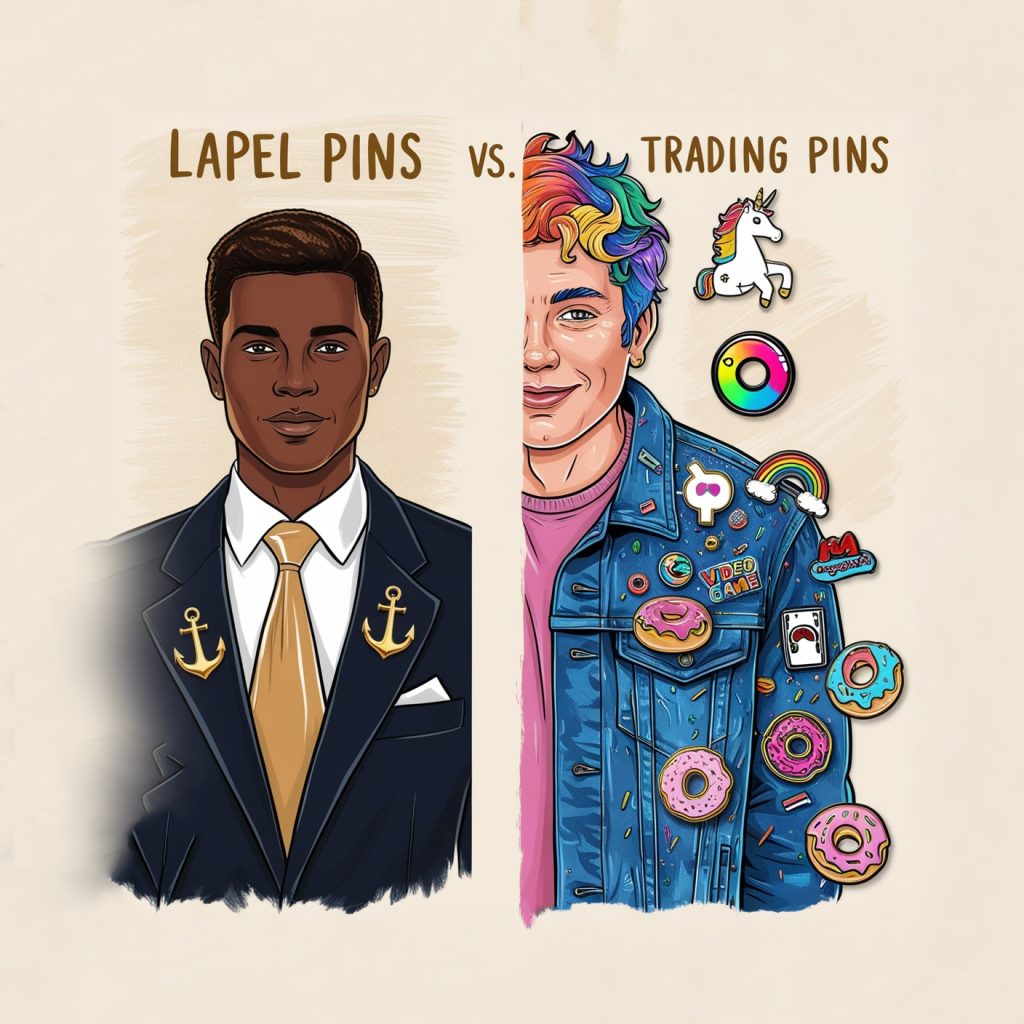In the world of collectibles, few items offer the same charm, nostalgia, and versatility as pins. From sports events and theme parks to corporate branding and personal expression, pins have long been a favorite among collectors. But for those just entering the collecting world or looking to expand their collection, one question looms large: should you focus on lapel pins or trading pins? Each type of pin brings its own unique appeal, and deciding between the two can feel like a true collector’s dilemma.
Lapel pins and trading pins might look similar on the surface, but their purposes, styles, and collecting communities can differ dramatically. Lapel pins are typically smaller, more formal, and often used for professional or personal identity. Meanwhile, trading pins are typically larger, bolder, and designed for the fun of trading, especially at sports events or conventions. Both have passionate fan bases, unique design possibilities, and exciting opportunities for collectors. So, which should you choose?
In this article, we’ll dive into the fascinating worlds of both custom lapel pins and trading pins, exploring their history, designs, collecting culture, and the pros and cons of each. Whether you’re a seasoned collector looking to start a new pin journey or someone who’s curious about the hobby, this guide will help you decide which type of pin suits your collecting style.
1. Understanding the Difference Between Lapel Pins and Trading Pins
Before choosing between lapel pins and trading pins, it’s essential to understand what sets these two types of pins apart. While they both fall under the broad category of collectible pins, they serve different purposes and appeal to different types of collectors.
1.1. What Are Lapel Pins?
Lapel pins are small, decorative pins that are typically worn on the lapel of a jacket, shirt, or other garment. They come in a variety of designs, ranging from subtle corporate logos to intricate personal symbols or messages. Often, lapel pins are used to show affiliation with an organization, support a cause, or express one’s personality in a professional or formal setting. Collecting lapel pins can be a refined hobby, with collectors often focusing on pins related to specific events, companies, clubs, or milestones.
- Example: A lapel pin featuring the logo of a prestigious club or organization is often worn by members to signify their affiliation, whether it’s a golf club, corporate board, or charitable society.
- Pro Tip: Collectors who appreciate sophistication, history, or symbols of prestige often lean toward collecting lapel pins. Look for lapel pins with historical significance or those representing prestigious organizations to add value to your collection.
1.2. What Are Trading Pins?
Trading pins are larger and typically bolder in design compared to lapel pins. They are most commonly associated with sports, particularly youth baseball, softball, hockey, and other team sports. These pins are designed for trading at events, allowing fans, players, and collectors to swap pins with one another. Trading pins are often brightly colored and eye-catching, featuring mascots, logos, and event themes. The main appeal of trading pins is the fun of collecting and trading, making them highly interactive for enthusiasts.
- Example: At a Little League tournament, players might swap trading pins featuring their team’s mascot or logo, collecting a wide variety of pins from teams they’ve competed against throughout the season.
- Pro Tip: If you love the social aspect of collecting, enjoy attending events, or want to interact with a community of fellow collectors, trading pins might be the perfect choice.
1.3. Key Differences Between Lapel Pins and Trading Pins
While lapel pins and trading pins may seem similar at first glance, several key differences set them apart:
- Purpose: Lapel pins are often used for personal expression, corporate branding, or as tokens of affiliation, while trading pins are meant for social interaction and the excitement of trading.
- Size: Lapel pins are typically smaller and more subtle, while trading pins are larger and more colorful.
- Design: Lapel pins often feature sleek, elegant designs suitable for professional settings, whereas trading pins are bold, fun, and designed to stand out in a crowd.
- Collecting Style: Lapel pin collectors may focus on finding rare or historical pins, while trading pin collectors often enjoy swapping pins to complete a set or build a diverse collection.
Understanding these distinctions will help you decide which type of pin best suits your collecting goals.
2. The Appeal of Lapel Pins: Why Choose Lapel Pins for Your Collection?
Lapel pins have been around for centuries, with a rich history that dates back to the use of brooches and other small pins as decorative accessories. Today, lapel pins have evolved into a symbol of personal expression, professional identity, and affiliation with causes or organizations. For collectors, lapel pins offer a world of possibilities, from corporate and political pins to creative, custom designs.
2.1. The History of Lapel Pins
The tradition of wearing small decorative pins on clothing has been around since ancient times, but the modern lapel pin became popular in the late 19th and early 20th centuries. During this time, lapel pins were often used as a way to show allegiance to political parties or military units. Soldiers, for example, would wear lapel pins featuring their division’s insignia or national symbols.
- Example: During World War I, soldiers wore lapel pins with patriotic symbols like flags and eagles, a trend that continued throughout subsequent wars and into the corporate world.
- Pro Tip: Vintage military lapel pins and political campaign pins from the early 20th century are highly sought after by collectors. If you’re interested in history, these types of pins can be a valuable addition to your collection.
2.2. The Sophistication of Lapel Pins
One of the main reasons collectors are drawn to lapel pins is their elegance and sophistication. Unlike trading pins, which are often fun and whimsical, lapel pins are more subtle and can be worn in formal settings. Whether you’re at a business meeting, a gala, or a wedding, a well-designed lapel pin can add a touch of class to your outfit while showcasing your interests or affiliations.
- Example: A lapel pin featuring a corporate logo might be worn by employees during a company event or conference. Similarly, a lapel pin with a charity’s emblem could be worn to show support for a cause.
- Pro Tip: Collect lapel pins that represent prestigious organizations, professional affiliations, or personal milestones. These pins often hold sentimental or historical value, making them valuable in a collection.
2.3. Lapel Pins as Tokens of Achievement and Affiliation
For many collectors, the appeal of lapel pins lies in their association with personal achievements, membership in exclusive groups, or support for important causes. Collecting lapel pins can be a way to celebrate milestones in your career, commemorate special events, or show loyalty to organizations you care about.
- Example: Many companies award lapel pins to employees who reach certain milestones, such as 10 or 20 years of service. These pins often feature the company’s logo and are cherished by employees as a symbol of loyalty and accomplishment.
- Pro Tip: Consider collecting lapel pins that represent personal milestones, such as pins from companies you’ve worked for, charities you’ve supported, or events you’ve attended. These pins often carry sentimental value and tell the story of your personal and professional journey.
2.4. Artistic and Custom Lapel Pin Designs
In addition to their historical and professional appeal, lapel pins can also be works of art. Many artists and designers create custom lapel pins as a way to express their creativity. These pins often feature intricate designs, bold colors, and unique materials, making them highly collectible for those who appreciate fine craftsmanship.
- Example: A designer might create a limited-edition lapel pin featuring a hand-drawn illustration or an abstract design. These pins are often released in small batches, making them rare and valuable for collectors.
- Pro Tip: Keep an eye out for limited-edition lapel pins created by independent artists or designers. These pins often have unique designs and are highly sought after by collectors who appreciate artistry and craftsmanship.
3. The Fun of Trading Pins: Why Choose Trading Pins for Your Collection?
While lapel pins offer sophistication and subtlety, trading pins are all about fun, social interaction, and the excitement of trading with other collectors. For those who love attending events, meeting new people, and building a diverse collection, trading pins are a perfect choice.
3.1. The History of Trading Pins
Trading pins have a long history in the world of sports, particularly in youth baseball and softball leagues. The practice of trading pins began in the 1980s and quickly became a popular tradition at Little League World Series tournaments, where players would trade pins with teams from around the country and even the world. Today, trading pins are a staple at many sports events, from hockey and soccer tournaments to the Olympic Games.
- Example: At the Little League World Series, players often trade pins featuring their team’s logo, mascot, or colors with players from other teams. The goal is to collect as many pins as possible while forming friendships with fellow athletes.
- Pro Tip: If you enjoy sports or love the thrill of trading, trading pins might be the perfect addition to your collection. Start by collecting pins from your favorite sports events or teams, and look for opportunities to trade with other collectors.
3.2. The Social Aspect of Trading Pins
One of the biggest draws of trading pins is the social aspect. Collectors of trading pins often attend events specifically to trade pins with other collectors, making it a highly interactive hobby. Whether you’re at a sports event, a theme park, or a convention, trading pins with others is a fun way to connect with fellow enthusiasts and grow your collection.
- Example: At a Disney theme park, pin trading is a popular activity among visitors. Guests can purchase Disney trading pins and exchange them with other guests or with cast members throughout the park. This creates a sense of community and excitement among pin traders.
- Pro Tip: To get the most out of trading pins, attend events where pin trading is encouraged, such as sports tournaments, conventions, or theme parks. Bring extra pins to trade with others, and don’t be afraid to strike up conversations with fellow collectors.
3.3. The Creative and Bold Designs of Trading Pins
While lapel pins tend to be more understated, trading pins are known for their bold and creative designs. From vibrant colors and fun characters to eye-catching shapes and interactive elements (like spinning parts or glitter), trading pins are designed to stand out and make a statement. For collectors who love creativity and playful designs, trading pins are an exciting option.
- Example: A hockey team might create a trading pin that features a spinning puck or flashing lights, adding an interactive element to the pin. These unique features make the pin more desirable for collectors.
- Pro Tip: When collecting trading pins, look for pins with unique or interactive features, such as moving parts, glow-in-the-dark elements, or 3D designs. These pins are often more valuable and sought after by fellow collectors.
3.4. Completing Sets and Themed Collections
Another appealing aspect of trading pins is the opportunity to complete sets or build themed collections. Many trading pin series are released in sets, with different designs representing specific teams, events, or characters. Collectors often strive to complete these sets by trading pins with others, adding a fun challenge to the collecting process.
- Example: A theme park might release a limited-edition set of trading pins featuring different characters from a popular movie. Collectors who visit the park during a specific event can collect all the pins in the series, creating a complete set.
- Pro Tip: If you enjoy the challenge of completing sets, focus on collecting trading pins that are part of a series or that represent specific events. Look for opportunities to trade with other collectors to fill any gaps in your collection.
4. Weighing the Pros and Cons: Lapel Pins vs. Trading Pins
Now that we’ve explored the unique characteristics of both lapel pins and trading pins, it’s time to weigh the pros and cons of each. Understanding the advantages and challenges of collecting each type of pin will help you make an informed decision about which is right for you.
4.1. The Pros and Cons of Collecting Lapel Pins
Pros:
- Sophistication: Lapel pins are often elegant and suitable for professional or formal wear.
- Historical and Sentimental Value: Many lapel pins have historical significance or personal meaning, such as corporate, military, or political pins.
- Wide Variety: Collectors can find lapel pins related to a wide range of industries, organizations, and causes.
Cons:
- Limited Social Interaction: Collecting lapel pins is often a more solitary hobby, as there is less emphasis on trading or socializing compared to trading pins.
- Smaller Design Space: Lapel pins are generally smaller and may not offer as much room for bold, creative designs.
4.2. The Pros and Cons of Collecting Trading Pins
Pros:
- Interactive and Social: Trading pins are all about interaction and community, making them perfect for collectors who enjoy socializing and attending events.
- Creative Designs: Trading pins are often larger and more colorful, with plenty of room for creative and playful designs.
- Opportunities for Trading: The excitement of trading pins with others adds an element of fun and challenge to the hobby.
Cons:
- Less Formal: Trading pins are typically less formal than lapel pins, making them unsuitable for professional or elegant occasions.
- Event-Driven: Many trading pins are specific to certain events or teams, which can limit the scope of your collection if you don’t attend these events regularly.
Which Should You Choose—Lapel Pins or Trading Pins?
Ultimately, the choice between lapel pins and trading pins depends on your personal preferences as a collector. If you’re drawn to elegance, history, and professional symbolism, lapel pins might be the right choice for you. Collecting lapel pins offers the opportunity to curate a collection of meaningful and sophisticated items that can be worn with pride or displayed as tokens of personal achievement and affiliation.
On the other hand, if you’re looking for a more interactive and social collecting experience, trading pins offer endless opportunities for fun and creativity. Whether you’re attending sports events, conventions, or theme parks, trading pins provide a way to connect with others, swap stories, and build a collection of bold and unique designs.
Whichever type of pin you choose, the world of pin collecting is filled with excitement, creativity, and the joy of discovering new designs. Both lapel pins and trading pins allow you to explore your personal interests, share your passion with others, and grow a collection that tells your unique story. As a collector, you’ll find that these pins aren’t just simple accessories—they’re meaningful keepsakes that connect you to moments, events, and communities that shape your life. The journey of building a collection, regardless of which pins you focus on, is just as rewarding as the collection itself.If you are interested in buying high quality custom lapel pins, you can call us at 866-246-9375 or fill out a FREE quote form.




